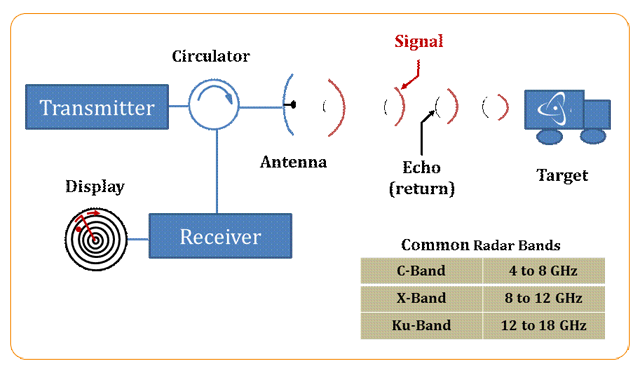Radar
What is Radar? How does it work?
A radar system has a transmitter that emits radio waves called radar signals in predetermined directions. When these come into contact with an object they are usually reflected or scattered in many directions. Radar signals are reflected especially well by materials of considerable electrical conductivity—especially by most metals, by seawater, by wet land, and by wetlands. Some of these make the use of radar altimeters possible. The radar signals that are reflected back towards the transmitter are the desirable ones that make radar work. If the object is moving either closer or farther away, there is a slight change in the frequency of the radio waves, caused by the Doppler effect.
Radar receivers are usually, but not always, in the same location as the transmitter. Although the reflected radar signals captured by the receiving antenna are usually very weak, these signals can be strengthened by electronic amplifiers. More sophisticated methods of signal processing are also used in order to recover useful radar signals.

The weak absorption of radio waves by the medium through which it passes is what enables radar sets to detect objects at relatively long ranges—ranges at which other electromagnetic wavelengths, such as visible light, infrared light, and ultraviolet light, are too strongly attenuated. Such things as fog, clouds, rain, falling snow, and sleet that block visible light are usually transparent to radio waves. Certain radio frequencies that are absorbed or scattered by water vapor, raindrops, or atmospheric gases (especially oxygen) are avoided in designing radars except when detection of these is intended.
Radar relies on its own transmissions rather than light from the Sun or the Moon, or from electromagnetic waves emitted by the objects themselves, such as infrared wavelengths (heat). This process of directing artificial radio waves towards objects is called illumination, although radio waves are invisible to the human eye or cameras.
Test needs are changing!
Radar Challenges:
|
Test Requirements
|
-
Detecting slow moving targets
-
Avoiding detection in hostile EW environment
-
Improving range resolution
-
Driving high power radar amplifiers
|
-
State-of-the-art ultra-low phase noise test signals
-
Fast switching signals
-
Industry leading RF pulse generation
-
Exceptionable high output power in the X-band and superb high power at other frequencies
|
Spanawave/Giga-tronics 2500B Microwave Signal Generators
Selector Guide
|
Model
|
|
|
|
|
|
|
|
Frequency Range
|
100 kHz to 2.5 GHz
|
100 kHz to 8 GHz
|
100 kHz to 20 GHz
|
100 kHz to 26.5 GHz
|
100 kHz to 40 GHz
|
100 kHz to 50 GHz
|
|
Narrow Pulse
|
10 ns
|
|
Switching Speed
|
0.5 ms
|
|
Output Power
|
+13 dBm
|
+13 dBm
|
+14 dBm
|
+10 dBm
|
+10 dBm
|
+5 dBm
|
|
Phase Noise
|
-109 dBc/Hz (at 10 GHz and 10 kHz offset)
-98 dBc/Hz (at 20 GHz and 10 kHz offset)
-92 dBc/Hz (at 40 GHz and 10 kHz offset)
|
|
Harmonics
|
-50 dBc
|
|
Spurious (20 GHz)
|
-60 dBc
|
|
Modulation
|
AM, FM, ØM, PM
|
|
Software |
Automation Xpress (included) |
|
Related Products
|
|
|
|
|
|
|
|




